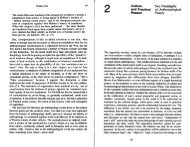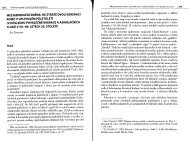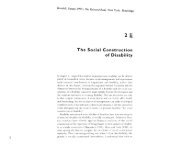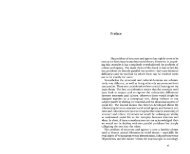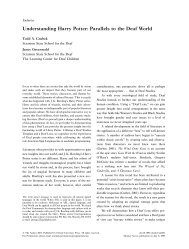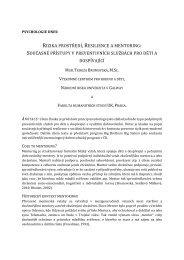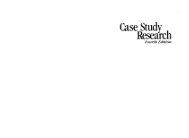Morphogenesis versus Structuration: On Combining ... - Moodle
Morphogenesis versus Structuration: On Combining ... - Moodle
Morphogenesis versus Structuration: On Combining ... - Moodle
Create successful ePaper yourself
Turn your PDF publications into a flip-book with our unique Google optimized e-Paper software.
<strong>Morphogenesis</strong> <strong>versus</strong> structuration 459<br />
(which has more voluntaristic connotations). Condensed in the brief<br />
statement that 'structure is both medium and outcome of the reproduction<br />
of practices'l6 is his method of bridging this dichotomy. The<br />
central notion of the 'duality of structure' makes up the bridge by<br />
dropping two planks from opposite banks so that they lie juxtaposed.<br />
First he advances the essential contribution made by knowledgeable<br />
actors in generating/transforming recurrent social practices-which in<br />
turn creates the 'visible pattern' that constitutes the social system for<br />
Giddens. Simultaneously, he lays down the fundamental proposition<br />
that when actors produce social practices they necessarily draw upon<br />
basic 'structural properties'-these essential factors being viewed as a<br />
matrix of rules and resources.<br />
Ideally what he wants to integrate is the way in which the active<br />
creation of social conditions is itself unavoidably conditioned by<br />
needing to draw upon structural factors in the process. Perhaps this<br />
is clarified by consulting the kind of practical images Giddens has in<br />
mind. The references to agents producing recurrent social practices<br />
summon-up a picture of the 'ruttedness' of routine action-in<br />
bureaucracy, for instance, where life is constantly breathed into inert<br />
rules which then deaden their animators through routinization.l7 But<br />
this is not the only picture he invokes. There is also metamorphosis,<br />
the generation of radically new practices when agency rides on the<br />
coat-tails of structural facilitation to produce social change of real<br />
magnitude. Although the 'duality of structure' spans both images, it<br />
provides no analytical grip on which is likely to prevail under what<br />
conditions or circumstances. The theory of 'structuration' remains<br />
fundamentally non-propositional.<br />
In other words the 'central notion' of the 'structuration' approach<br />
fails to specify when there will be 'more voluntarism' or 'more determinism'.<br />
In fact, on the contrary, the 'duality of structure' itself<br />
oscillates between the two divergent images it bestrides-between (a)<br />
the hyperactivity of agency, whose corollary is the innate volatility of<br />
society, and (b) the rigid coherence of structural properties associated,<br />
on the contrary, with the essential recursiveness of social life.<br />
(a) Hyperactivity is an ineluctable consequence of all rules and<br />
resources being defined as transformative, in contradistinction to the<br />
rigid transformational grammar of linguistics. Resources are readily<br />
convertible, rules endlessly interpretable; the former providing<br />
material levers for transforming the empirical domain, the latter<br />
transfiguring codes and norms. Consequently the spatio-temporal<br />
constitution of society is ordered in terms of the mediations and<br />
transformations made possible by these two structural properties,<br />
as manipulated by agents. However it follows that if structural<br />
properties are inherently transformative then actors generically enjoy<br />
very high degrees of freedom-at any time they could have acted<br />
otherwise, intervening for change or for maintenance. Hence the



